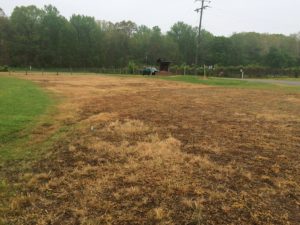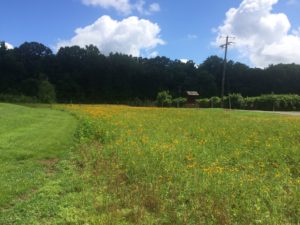Happy October to you. I thought I’d try to write something useful about herbicides which on the surface seems to be a boring topic. What? You mean you didn’t find chemistry fascinating in high school? Herbicides have caused quite a bit of angst lately. I encounter more and more folks who want to convert habitat, or control invasive plants without herbicides. Our team tries to accommodate those landowners as best we can, and occasionally there are some viable techniques…but by and large the proper use of herbicides is not only much more effective, but cheaper, and sometimes more environmentally sound in the long run. How so? For starters, running a tractor uses fuel and releases carbon into our atmosphere. To control non-native species like certain sod forming grasses without herbicides will require multiple cover crop plantings which would include disking, planting, and weeding by harrow, over a period of years. This equates to a lot of diesel fuel and tractor time. In other cases prescribed fire may not control the sapling vegetation as necessary to maintain early successional plant communities. The burn is releasing carbon into the atmosphere without accomplishing the habitat goals. Proper use of herbicides by following the label to the “T” could increase the effectiveness of the prescribed fire, better justifying the carbon released.
Let me also say, I love weeds and am not advocating getting rid of them. I refer only to how to rid an area of problem plants to make way for better wildlife plants – which may already be there in the seed bank. For a comprehensive, but concise study of herbicides, this link to a publication by Penn State is very useful: https://extension.psu.edu/introduction-to-weeds-and-herbicides . While it is based around agriculture, the information applies well to our work as wildlife habitat managers.
Herbicides can be overused, misused and downright abused. That generally starts with the applicator’s attitude that if the label calls for six ounces of product per gallon of water, twelve must be better. Hopefully they are not also applying that criteria to their coffee making every morning, or even worse, to their constipation meds (which one would likely only do once I suppose). All this stems from the fact that some folks think the herbicide label is just for “funnsies” and it is OK to skip straight to the mixing instructions, or if premixed, to use it immediately without any reading of the label at all. Wrong, wrong and wrong again. It is the law that the herbicide label must be followed strictly. As one of our long time senior private lands biologists likes to say matter of factly, “The Label IS the law.” It is illegal to mix it more strongly than specified, or to mix it with other herbicides not approved for mixing with it, or to apply it in any way that the label does not state is an approved method for use. This means proper mixing, timing of application, amount of application per acre (not only per application but per year), application height, application pressure, on the proper vegetation, when wind drift is minimized and atmospheric conditions are correct, while wearing the proper personal protective equipment. Unfortunately, sometimes these conditions are not met.
Problems can arise such as when an herbicide is not approved for use over or near water – if it is applied too close and spray drifts into the water, aquatic organisms can be harmed or killed. Other issues can arise when an active ingredient in a product is prone to vaporize and drift, especially during hot, humid weather. I have witnessed this first hand as herbicides were applied to a hay field very near my home to control broadleaved plants that detracted from the hay quality. In my case legumes like black locust and indigo bush were especially susceptible to the vapor drift of the herbicide applied. Both species were damaged or killed as far as 150 yards away from the application site. The applicator applied the herbicides on one of the hottest days of the summer when the wind was toward my home at 5 to 10 mph…not only a violation of the label but downright irresponsible. The heat caused the active ingredient to vaporize and the wind did the rest. If I was a bee keeper who valued locust honey I might have sued…but in my case a warning to the field owner is the only action I took. The point is, these types of misuses can give a bad name to otherwise good products.
As a counter to this situation, I recently had my clear-cut site prepped with herbicides by a contractor who used a mix containing some of the same ingredients in the hay field spray and had no issues at all with drift or off site kill. They applied the products when the atmospheric conditions were correct and winds were light. In my case, I hope to establish a mixed short-leaf pine and oak / hickory forest. The site had been in loblolly pine for 36 years. I had no idea how many loblolly pine seedlings were present in the vegetation until after it was sprayed and they began to turn brown. Without the herbicides, I don’t think my planted short-leaf pine would stand a chance against all the existing loblolly seedlings. In my case, herbicides are allowing me to re-establish a declining pine species and forest type.


If you plan to use herbicides, don’t wait until the day of application to read the label. It takes time to understand a product. Pay particular attention to the safety information. Some herbicides are extreme eye irritants and require eye protection be worn when applying. Always have a source of clean water for flushing your eyes on hand. This can be something as simple as several bottles of water with “sports” squeeze caps. I hope if you are new to habitat management you won’t discount herbicides as a positive tool for habitat change. And if you have been around a while, and have developed some bad habits, reconnect with your herbicide labels.
Common uses of herbicides for wildlife habitat management:
- Converting non-native cool season grasses to native species and wildflowers.
- Control of highly invasive shrubs, forbs and grasses that prevent establishment of wildlife habitat.
- Control of an overabundance of understory hardwood and pine saplings in a pine or oak savanna setting, particularly when prescribed fire alone has been delayed, or has not proven fully effective.
- To aid in crop tree release – controlling competitors of mast producing or pollinator trees.
- To create snags for cavity nesters more effectively than tree girdling alone.
- To regain control of old fields where disking or mowing is no longer practical, and saplings have grown beyond effective prescribed fire control.
Just as with our medications at home, the key to using herbicides is to use them correctly.


